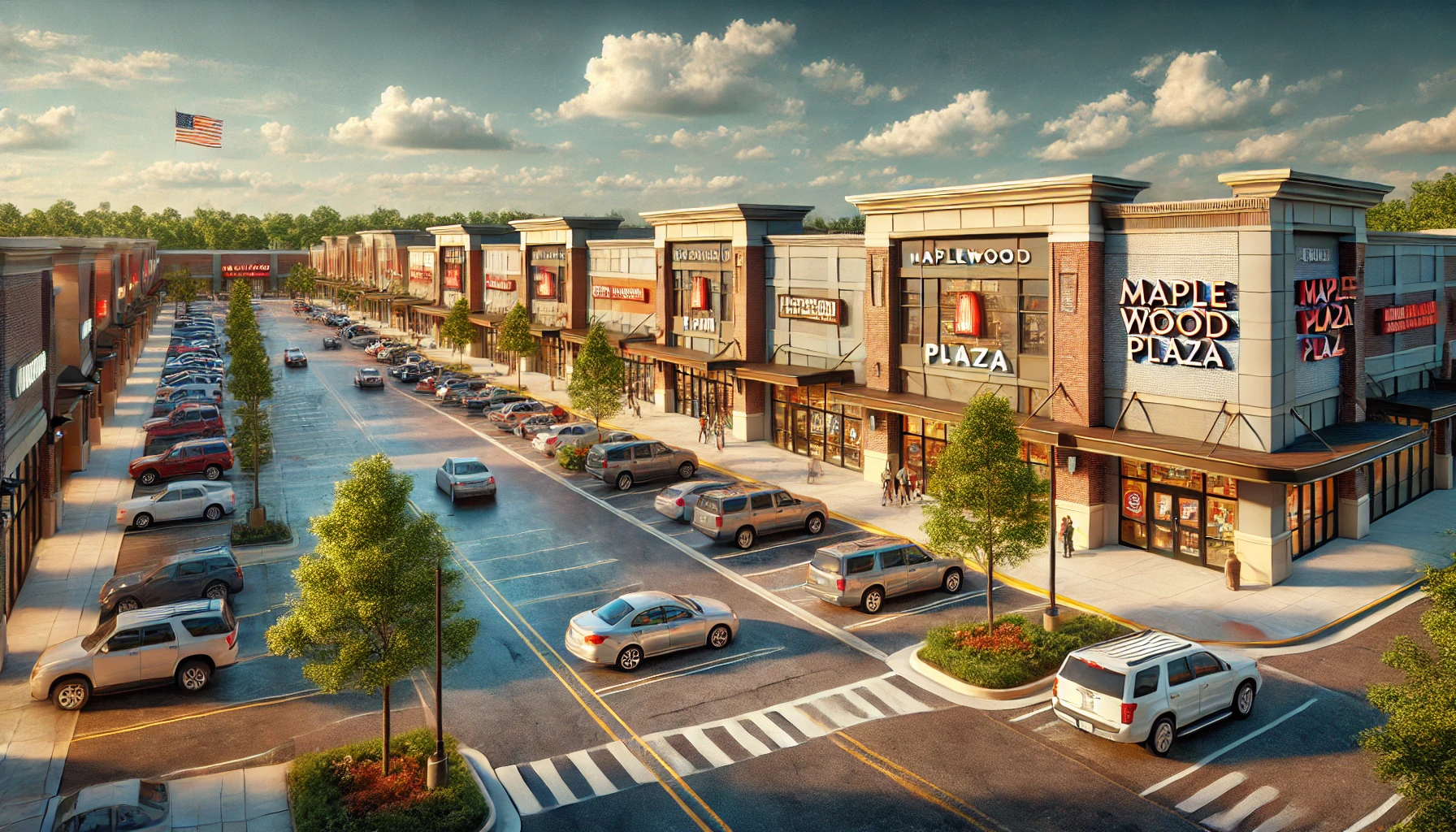Case Study #12 – Maplewood Plaza: Value-Add Retail (Case Only)
For our 12th case study, we offer a challenging opportunity with a value-add retail case study. These case studies are meant to help you practice mastering real estate financial modeling. The Maplewood Plaza case study puts you in the role of an Acquisition Analyst at Legacy Retail Partners, a family office based in Milwaukee, WI.
In this case, you’ll evaluate Maplewood Plaza, a 20,000-square-foot retail center located in a suburban market of Chicago, IL. The property has a strong history but currently faces challenges with occupancy and management inefficiencies.
Practice makes perfect! This is a real scenario based on actual properties and situations. Names and locations have been changed for confidentiality reasons, but the fundamentals are real-to-life.
Each case study shared in this series mirrors real world situations, either in terms of the types of deals you will look at in various roles or the types of modeling tests you’ll be required to perform as part of the interview process. You can browse this and other case studies in the A.CRE Library of Real Estate Case Studies.
Are you an Accelerator Advanced member? Download this case study files for free in the Career Advancement Endorsement. Not yet an Accelerator member? Consider enrolling today in the Accelerator, the industry’s go-to real estate financial modeling training program used by top companies and elite universities to train the next generation of CRE professionals.
MAPLEWOOD PLAZA – THE BACKGROUND
You are an Acquisition Analyst at Legacy Retail Partners, a 3rd generation family office based in Milwaukee, WI. Legacy Retail Partners’ multitenant retail strategy focuses on value-add acquisitions of unanchored and anchored retail centers with a strong occupancy history, below-market in-place rents, and locations in markets and submarkets with a clear supply-demand imbalance.
The firm aims to acquire existing retail assets, whether on or off market, and over a 5–7-year hold period, improve tenant quality and occupancy, roll below market rents to market, and enhance value through strategic capital improvements and institutional management.
MAPLEWOOD PLAZA – THE DETAILS
Legacy Retail Partners has recently identified a potential acquisition target: Maplewood Plaza, a 2009-built, 20,000-square-foot retail center located in an established suburban market of Chicago, IL. The submarket boasts strong population, income, and job growth and has a relatively low 4.1% neighborhood retail vacancy rate. The property has averaged 93.4% occupancy over the past 15 years.
Despite the strong supply and demand dynamics, two tenants recently vacated, leaving the center currently 70% occupied with a mix of local and national tenants. The current out-of-state private owner has struggled with management inefficiencies and lacks the capital needed for necessary capital expenditures and leasing costs, resulting in below-market occupancy and rents.
Attachments:
- Maplewood Plaza – Economics (Excel file).
General Assumptions:
- 60-month hold period (61 periods including month 0).
- Analysis start (Month 0): 12/31/2024.
- Use monthly periods, with periods ending on the last day of each month.
Acquisition Assumptions:
- Asking Price: $6,050,000.
- Due Diligence and Legal Cost: $40,000.
- Closing Cost: $25,000.
- Deferred Maintenance: $250,000 spent straight-line in months 1 – 4.
Operating Assumptions:
- All tenants roll to market at lease expiration.
- Suite 104 leases at $25/SF in month 3, suite 109 leases at $25/SF in month 6.
- 3% annual market rent growth.
- Leasing Assumptions:
- Renewal probability: 75%
- Tenant Improvements: $12.50 (new) / $6.25 (renew)
- Leasing Commissions: 6% of base rent (new) / 0% of base rent (renew)
- Lease term: 5 years (new) / 5 years (renew)
- Free rent: None
- Downtime: 4 months
- Reimbursement: Tenants reimburse 100% of their pro rata share of total net rentable area (NRA) with no caps (e.g. Hungry Bagel reimburses 2,000/20,000 = 10% of CAM, management, insurance, and property taxes).
- Credit Loss: 0%
- General Vacancy: 5% of Total Potential Income.
- 3% annual operating expense growth.
- 3% annual capital expenditures (Misc. CapEx and tenant improvements) growth.
Financing Assumptions:
- Loan Assumption: Existing LifeCo loan, interest-only, $2,500,000 outstanding loan balance, 25 months remaining on existing term (payoff in month 25), monthly payment of $7,812.50.
- Loan assumption fee: 25bps of the outstanding loan balance.
- Permanent Loan (refinance in month 25): sized to max 1.25x DSCR (on NOI), max 65% LTV (assume 6.75% cap rate on T12 NOI), and minimum 9.0% debt yield; 6.25% interest rate, 30-year amortization.
- Loan closing costs: 1.0% of permanent loan amount.
Reversion Assumptions:
- Sell in month 60
- Exit cap rate: 6.75%
- Calculate sale price based on projected F12 NOI (months 61 – 72).
- Selling costs 2.5% of sales price.
Partnership Structure Assumptions:
- GP Fees:
- Acquisition fee: 1.0% of purchase price paid by partnership to GP in month 0.
- Asset Management fee: $25,000 per year paid by partnership monthly to GP.
- Contribution Percentages:
- 10% Legacy Retail Partners (GP)
- 90% Limited Partners (LP)
- Distribution waterfall:
- First to the partners, pro rata and pari passu based on contribution % until the LP has achieved a 9% internal rate of return (using Excel’s XIRR function);
- Second, a 20% promote paid to the GP, with remaining cash flow distributed to the partners pro rata and pari passu based on contribution % until the LP has achieved a 9% internal rate of return (using Excel’s XIRR function);
- Lastly, a 30% promote paid to the GP, with remaining cash flow distributed to the partners pro rata and pari passu based on contribution %.
MAPLEWOOD PLAZA – THE TASK
Part 1: Valuation Using the Direct Cap and DCF Method
- What going-in cap rate is the broker assuming to arrive at their asking price?
- Assuming the partnership needed a minimum gross unlevered IRR of 9.0% on this 60-month investment, what is the max price Legacy Retail Partners should pay?
Part 2: Anatomy of the Real Estate DCF
- Build a 5-year DCF model to project the cash flows.
- Include the effects of lease-up, rent growth, and operating expense growth.
- Model the refinancing at the start of year 3.
- Calculate the terminal value.
Part 3: Key Risk and Return Metrics
- Calculate the gross (i.e. property-level) unlevered and levered IRR.
- Calculate the gross (i.e. property-level) unlevered and levered equity multiple.
- Calculate the untrended yield-on-cost.
- Compare the untrended yield-on-cost to the exit cap rate to calculate an untrended Development/Investment Spread for this investment.
- Determine the LTV, DSCR, and Debt Yield at refinancing and for the permanent loan.
Part 4: Modeling Debt – Bridge and Permanent Debt
- Calculate the annual debt service for both the loan assumption and the permanent loan.
- Calculate the loan amount of the permanent loan.
- Calculate the loan payoff for both loans.
Part 5: Partnership-Level Mo del
- Add a partnership cash flow module (i.e. equity waterfall), calculating contributions from and distributions to the partners.
- Calculate the total return of capital, preferred return, and excess cash flow received by the LP. Calculate the LP’s net returns (IRR and Equity Multiple).
- Calculate the total return of capital, preferred return, promote, and excess cash flow received by the GP (do NOT include GP fees in GP return calculations). Calculate the LP’s net returns (IRR and Equity Multiple).
- Calculate total GP fees earned.
- Include an Error Check to ensure that all property-level cash flow is appropriately distributed between the partners.
MAPLEWOOD PLAZA – EXTRA CREDIT I
Legacy Retail Partners is considering adding a 25-month mezzanine loan to the capital stack to provide further leverage. The mezzanine loan terms are as follows:
- Loan Amount: $1,500,000
- Interest Rate: 350bps + SOFR (see SOFR yield curve in ‘Economics’ xlsx)
- Term: 25 months, interest-only
Incorporate the mezzanine loan into your model and recalculate the gross and net IRR and equity multiple.
MAPLEWOOD PLAZA – EXTRA CREDIT II
Legacy Retail Partners’s LP partner is considering holding this investment long-term. Given that the value-add plan is fully executed by the end of the 5-year hold period, the partners have agreed that if the LP chooses to hold the investment beyond month 60 that the GP’s promote would be crystallized in month 60.
Based on that, calculate the GP’s new ownership share as of month 61 in a scenario where GP’s promote is crystallized in month 60.
Create Your Own Case Study
This case study offers a view of the decisions involved in a value-add retail investment. As you apply the provided data and strategies in your career interviews and financial models, you’ll gain insights into optimizing asset value and ensuring investment criteria are met, key skills for any CRE professional. For those looking to deepen their expertise, our Real Estate Case Study Creator provides a platform to test and enhance your modeling skills in a controlled, realistic setting.
This GPT creates completely custom real estate case studies from scratch and allows users to craft case studies to simulate scenarios they are interested in or expect to encounter in their professional lives. This customization allows users to focus on particular areas of interest or challenge, making the practice sessions as relevant and effective as possible. We encourage both seasoned practitioners and newcomers to use this resource to refine their approach and decision-making in commercial real estate investments.
Additionally, after completing this Maplewood Plaza: Value-Add Retail Case Study, you can use the Real Estate Case Study Creator GPT to analyze your results and provide an assessment of your strategies and outcomes. We encourage both seasoned practitioners and newcomers to use this resource to refine their approach and decision-making in commercial real estate investments.
- Note: Custom GPTs are now available to both paid and free users of ChatGPT. Click here to learn more.
Download the Case PDF
In addition to the web-based case, we’ve created a PDF version to download and use offline. As with our real estate financial models, this case study is offered on a “Pay What You’re Able” basis with no minimum (enter $0 if you’d like) or maximum (your support helps keep the content coming). Just enter a price together with an email address to send the download link to, and then click ‘Continue’.
We occasionally update these cases (see version notes). Paid contributors will receive lifetime access to the case, and all updates.
Frequently Asked Questions about Case Study #12 – Maplewood Plaza: Value-Add Retail
Version Notes
v1.0
- Initial release









